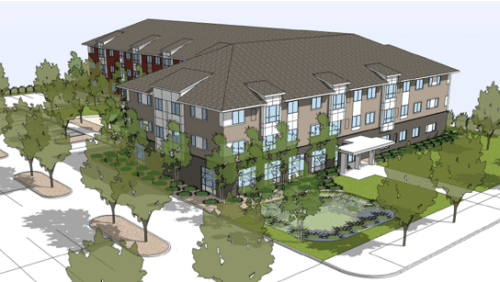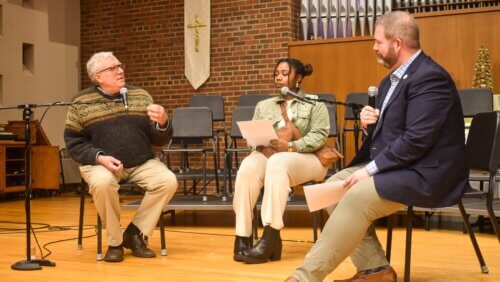Responding To This Moment
Encampment Research Team Spotlight, By Dylan Novacek – Content Specialist
“Home needs to be a place of healing and health. A grounding place,” said Jim Bargmann of Mount Olive Lutheran Church in Minneapolis. “Our neighbors living in tents a few blocks away don’t have that sense of healing and stability.”
Our housing crisis is worsening, and the pandemic only amplifies it. At a time where we are asked to shelter in place, hundreds of people are found setting up camp in our local parks. Two blocks away from Jim’s congregation stands Powderhorn Park. By early June, 400 people were living there.
![]() “I was walking back to my office from the encampments feeling frustrated,” he huffed. “It’s frustrating because we have the resources to care for these people. I thought to myself: what’s my sphere of influence?”
“I was walking back to my office from the encampments feeling frustrated,” he huffed. “It’s frustrating because we have the resources to care for these people. I thought to myself: what’s my sphere of influence?”
These tent encampments arose in the midst of the pandemic and in the wake of George Floyd’s murder by police, which brought the systemic racism behind our housing crisis into view for many people. With a desire to respond to the needs of our community, the encampment research team was formed.
“We formed this team this summer in response to our deep concern for people falling through the cracks of our current systems for shelter and housing,” shared Beacon Congregational Organizer Emily Goldthwaite Fries. “We were hearing from congregation members who wondered, as we see people struggling to live outdoors in the city, how can we be part of the solution?”
The people on this team were largely those who reached out to Beacon with concern about people in encampments and expressed a deep desire for understanding how to help. They come from seven different congregations, and we are all grateful for their work.
“Our neighbors at the encampments don’t live with the sense of safety that we’re all entitled to,” remarked Mary Bujold, from the Basilica of Saint Mary. In her professional career, Mary has experience working on feasibility studies for different types of residential developments. For her, this research work felt natural.
“I read media reports that try to paint a picture of the homeless issue getting better. But it certainly is not,” she asserted. “People go uncounted. And our current shelter system simply isn’t adequate.”
As the team came together, they sought to understand the immediate needs of those at the encampments through primary research. By connecting with organizations such as the zAmya Theater Project, the Powderhorn Neighborhood Association, Avivo and more, they grew their understanding of how to support the vision that all people have a home.
“We approached our interviews with the belief that people experiencing homelessness and those working closely with them are already dreaming and working on solutions,” Emily said. “We intentionally took the time to listen before forming our own sense of how Beacon should respond.”
For members of the research team, a shared sense of community and camaraderie was built as they walked together in these key learnings of the moment.
“We’re seeing a growing number of people who have been without a home for a long time. They have family members who have been homeless for years,” Mary reflected. “We are beginning to see generational homelessness.”
“The consistent theme that has stuck out to me is the fact that we need more diverse housing options,” Jim added. “We have a diverse group of people we are trying to serve. We need to ask ourselves: are we representing the people who need housing?”
Within the team’s research findings, a tremendous amount of hope was lifted up as we look to best serve our neighbors in a time of crisis.
![]() “In each interview we asked what is giving people hope, and again and again we heard that we are living in a historic moment of awareness that should not be wasted,” Emily shared. “In the midst of this crisis, we also have the opportunity to make a bigger difference than ever before toward the vision that all people have a home.”
“In each interview we asked what is giving people hope, and again and again we heard that we are living in a historic moment of awareness that should not be wasted,” Emily shared. “In the midst of this crisis, we also have the opportunity to make a bigger difference than ever before toward the vision that all people have a home.”
At Beacon, we are united in this vision as we engage our faith communities to step forward to help make meaningful change in the lives of the people we serve. An important step in that work is understanding how important supportive housing truly is.
![]() In St. Paul, Beacon’s American House and Kimball Court offer a Housing First model, where support staff recognizes that various aspects of people’s lives and needs are tied together, so they should be addressed together. Construction is soon to begin on Bimosedaa in downtown Minneapolis, offering about 50 more apartments for adults in the Housing First model.
In St. Paul, Beacon’s American House and Kimball Court offer a Housing First model, where support staff recognizes that various aspects of people’s lives and needs are tied together, so they should be addressed together. Construction is soon to begin on Bimosedaa in downtown Minneapolis, offering about 50 more apartments for adults in the Housing First model.
“A whole continuum of housing and shelter solutions is needed in our community,” expressed Emily. “Our collaborative has expertise in the long term solutions of housing development and policy change – understanding that this work takes years, we felt an urgency to learn from people closest to the encampments so that our future work could begin to be informed by the learnings of the moment.”
As supporters of Beacon, team members like Mary and Jim found inspiration for this work by being in community with one and other. Through being at the table together as advocates, this research team is a prime example of how collaboration makes a huge difference.
“There are important stories that need to be heard,” Mary insisted. “Stories that will help us gain an understanding of how we can move forward. The creation of more diverse and supportive housing will change lives. Knowing that this work can do that inspires me.”
“For us to sit around the table with people who have a passion for housing is impactful,” Jim exclaimed. “When we can make a difference in the lives of others, so someone can be more safe and secure…that’s what motivates me. No one of us can fix this problem on our own. But together, we can do it!”
One way Beacon is making change is through the creation of more homes under the Housing First model. Learn more on how we are creating new homes like Bimosedaa all November at Beacon Now. Click here to learn more or contact Craig Freeman for more information.
![]()


